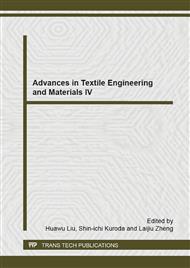p.268
p.272
p.281
p.285
p.290
p.294
p.298
p.303
p.309
A Study of Uyghur Folk Carpet Pattern
Abstract:
Uyghur carpet is the traditional Uyghur handicraft, it is the fusion of spinning, dyeing, knitting and painting with both practical and artistic value. Its origination dates back to more than 2000 years ago and it has been evolving gradually ever since along with the economic development. In recent years, carpet samples with thousands of years history have been discovered in the ruins of ancient tomb in Niya, Shanpula, Yuli, Zhagunluke, Talimu and Peacock River. Scholarships are amazed at the carpets’ unique patterns, delicate quality and fine colors. These carpets are weaved with patterns of human figure, animal and god bird. These patterns are surrounded by designs of beautiful flower and scenery. Some patterns contain auspicious words. The weaving technique, pattern designs and color scheme not only reflect how ancient Uyghur people think about the world, their appreciation of beauty and value of life, but also demonstrate their nature to pursue, and create aesthetic value and their enjoyment of beauty.
Info:
Periodical:
Pages:
290-293
Citation:
Online since:
October 2014
Authors:
Price:
Сopyright:
© 2014 Trans Tech Publications Ltd. All Rights Reserved
Share:
Citation:


